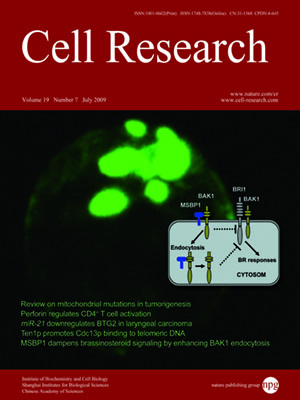
Volume 19, No 7, Jul 2009
ISSN: 1001-0602
EISSN: 1748-7838 2018
impact factor 17.848*
(Clarivate Analytics, 2019)
Volume 19 Issue 7, July 2009: 849-863
ORIGINAL ARTICLES
Ten1p promotes the telomeric DNA-binding activity of Cdc13p: implication for its function in telomere length regulation
Wei Qian1,2, Jianyong Wang1, Na-Na Jin2, Xiao-Hong Fu1, Yi-Chien Lin3, Jing-Jer Lin3 and Jin-Qiu Zhou1
1The State Key Laboratory of Molecular Biology, Institute of Biochemistry and Cell Biology, Shanghai Institutes for Biological Sciences, Chinese Academy of Sciences, The Graduate School of Chinese Academy of Sciences, Shanghai 200031, China
2Department of Biochemistry, School of Medicine, Nantong University, Nantong, Jiangsu 226001, China
3Institute for Biopharmaceutical Science, National Yang-Ming University, Shih-Pai, 112, Taipei, Taiwan
Correspondence: Jin-Qiu Zhou,(jqzhou@sibs.ac.cn)
In
Saccharomyces cerevisiae, the essential gene
CDC13 encodes a telomeric single-stranded DNA-binding protein that interacts with Stn1p and Ten1p genetically and physically, and is required for telomere end protection and telomere length control. The molecular mechanism by which Ten1 participates in telomere length regulation and chromosome end protection remains elusive. In this work, we observed a weak interaction of Cdc13p and Ten1p in a gel-filtration analysis using purified recombinant Cdc13p and Ten1p. Ten1p itself exhibits a weak DNA-binding activity, but enhances the telomeric TG
1–3 DNA-binding ability of Cdc13p. Cdc13p is co-immunoprecipitated with Ten1p. In the mutant
ten1-55 or
ten1-66 cells, the impaired interaction between Ten1p and Cdc13p results in much longer telomeres, as well as a decreased association of Cdc13p with telomeric DNA. Consistently, the Ten1-55 and Ten1-66 mutant proteins fail to stimulate the telomeric DNA-binding activity of Cdc13p
in vitro. These results suggest that Ten1p enhances the telomeric DNA-binding activity of Cdc13p to negatively regulate telomere length.
Cell Research (2009) 19:849-863. doi: 10.1038/cr.2009.67; published online 16 June 2009
FULL TEXT | PDF
Browse 1841


